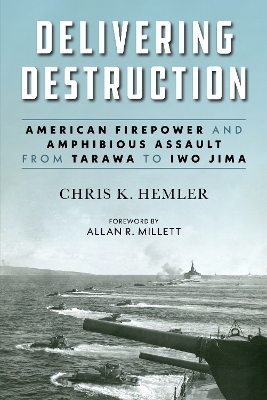
Delivering Destruction
American Firepower and Amphibious Assault from Tarawa to Iwo Jima
Seiten
2023
Naval Institute Press (Verlag)
978-1-68247-134-0 (ISBN)
Naval Institute Press (Verlag)
978-1-68247-134-0 (ISBN)
Offers a detailed study of American ‘triphibious’ (land, sea, and air) firepower coordination in the Pacific War. In describing the Amphibious Corps’ development of fire coordination teams and tactics in the Central Pacific, Hemler underlines the importance of adaptation, coordination, and the primacy of the human element in naval combat.
Existing literature maintains that the U.S. Marine Corps’ operational success in the Pacific War rested upon two dominant themes: committed theoretical preparation and courageous battlefield action. Put simply, the Marines wrestled with the conceptual challenges of the amphibious assault in the 1920s and 1930s and developed the tools and methods necessary to seize a hostile beach. When Japanese forces attacked at Pearl Harbor in 1941, the Corps sent its brave and spirited infantrymen to advance across the enemy-held islands of the South and Central Pacific. But the full story runs much deeper. Though this conventional narrative captures essential elements of the U.S. Navy and Marine Corps' triumph, it fails to account for substantial interwar deficiencies in fire control and coordination, as well as the critical wartime development of those capabilities between 1942 and 1945.
Delivering Destruction is the first detailed study of American triphibious (land, sea, and air) firepower coordination in the Pacific War. In describing the Amphibious Corps' development of fire coordination teams and tactics in the Central Pacific, Hemler underlines the importance of wartime adaptation, battlefield coordination, and the primacy of the human element in naval combat. He reveals the untold story of American fire control and coordination teams in the Central Pacific. Through “bottom-up” adaptation and innovation, American troops and officers worked out practical solutions in the field, learning to effectively apply and integrate air and naval support during a contested amphibious assault. The Americans' ability to mount tremendous, synchronized firepower at the beachhead–a capability established through three years of grueling wartime adaptation–allowed the U.S. Navy and Marine Corps to seize any fortified Japanese island of its choice by 1945. ·Despite advancing technology and expanding “domains” of warfare, combat remains a deeply interactive, human endeavor.
Existing literature maintains that the U.S. Marine Corps’ operational success in the Pacific War rested upon two dominant themes: committed theoretical preparation and courageous battlefield action. Put simply, the Marines wrestled with the conceptual challenges of the amphibious assault in the 1920s and 1930s and developed the tools and methods necessary to seize a hostile beach. When Japanese forces attacked at Pearl Harbor in 1941, the Corps sent its brave and spirited infantrymen to advance across the enemy-held islands of the South and Central Pacific. But the full story runs much deeper. Though this conventional narrative captures essential elements of the U.S. Navy and Marine Corps' triumph, it fails to account for substantial interwar deficiencies in fire control and coordination, as well as the critical wartime development of those capabilities between 1942 and 1945.
Delivering Destruction is the first detailed study of American triphibious (land, sea, and air) firepower coordination in the Pacific War. In describing the Amphibious Corps' development of fire coordination teams and tactics in the Central Pacific, Hemler underlines the importance of wartime adaptation, battlefield coordination, and the primacy of the human element in naval combat. He reveals the untold story of American fire control and coordination teams in the Central Pacific. Through “bottom-up” adaptation and innovation, American troops and officers worked out practical solutions in the field, learning to effectively apply and integrate air and naval support during a contested amphibious assault. The Americans' ability to mount tremendous, synchronized firepower at the beachhead–a capability established through three years of grueling wartime adaptation–allowed the U.S. Navy and Marine Corps to seize any fortified Japanese island of its choice by 1945. ·Despite advancing technology and expanding “domains” of warfare, combat remains a deeply interactive, human endeavor.
Chris Hemler spent ten years on active duty in the U.S. Marine Corps, holding posts with the 24th Marine Expeditionary Unit, 2d Marine Aircraft Wing, and U.S. Naval Academy Marine Detachment. In 2019, he was awarded the General Lemuel Shepherd Memorial Dissertation Fellowship and Rear Admiral Samuel Eliot Morison Scholarship. He holds a PhD in Military History from Texas A&M University and currently serves as a Principal Advisor with Frontier Design Group.
| Erscheinungsdatum | 22.09.2023 |
|---|---|
| Reihe/Serie | Studies in Marine Corps History and Amphibious Warfare |
| Zusatzinfo | 4 maps, 16 b&w photos |
| Verlagsort | Annopolis |
| Sprache | englisch |
| Maße | 152 x 229 mm |
| Gewicht | 256 g |
| Themenwelt | Geschichte ► Allgemeine Geschichte ► Neuzeit (bis 1918) |
| Geschichte ► Allgemeine Geschichte ► 1918 bis 1945 | |
| Geschichte ► Teilgebiete der Geschichte ► Militärgeschichte | |
| Sozialwissenschaften ► Politik / Verwaltung | |
| ISBN-10 | 1-68247-134-9 / 1682471349 |
| ISBN-13 | 978-1-68247-134-0 / 9781682471340 |
| Zustand | Neuware |
| Informationen gemäß Produktsicherheitsverordnung (GPSR) | |
| Haben Sie eine Frage zum Produkt? |
Mehr entdecken
aus dem Bereich
aus dem Bereich
Giordano Bruno - ein ketzerisches Leben
Buch | Hardcover (2024)
C.H.Beck (Verlag)
29,90 €
das dramatische 16. Jahrhundert
Buch | Hardcover (2024)
Rowohlt Berlin (Verlag)
34,00 €
die Fahrt der Bounty und die globale Wirtschaft im 18. Jahrhundert
Buch | Hardcover (2024)
Klett-Cotta (Verlag)
25,00 €


